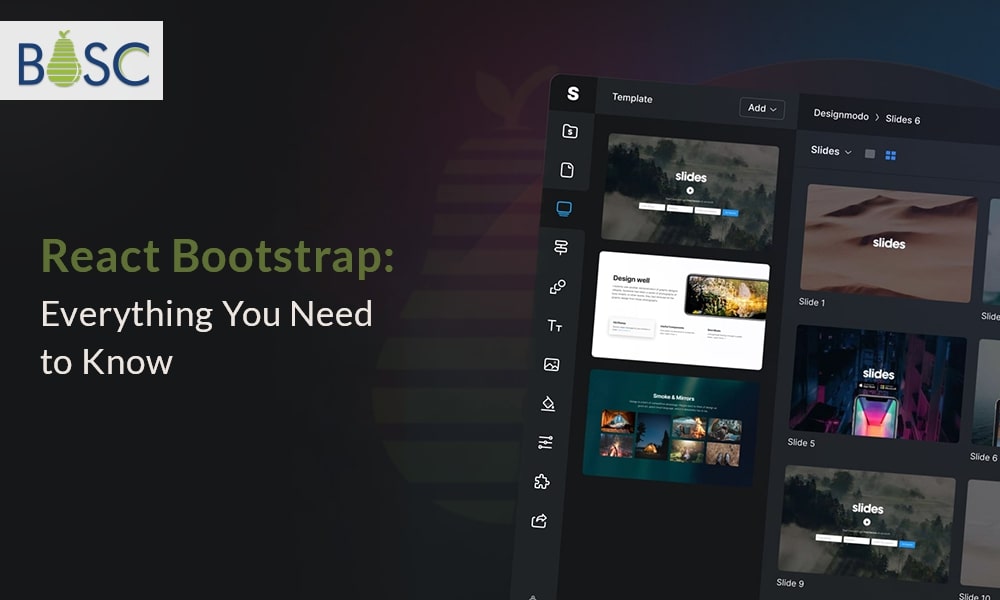The popularity of single-page apps over the past few years has led to a flood of JavaScript frameworks like Angular, React, Vue.js, Ember, and many others. As a result, building web apps no longer require using a DOM library like jQuery. This has corresponded with developing CSS frameworks intended to help programmers create responsive web applications.
Bootstrap is a potent CSS framework that enables programmers to create responsive web apps quickly. However, some people may find it difficult to integrate Bootstrap with React.
If you’re a front-end developer, you’ve probably used or heard of the responsive (mobile-first) CSS frameworks Bootstrap, Foundation, and Bulma, which all provide a wealth of features and built-in utilities. React is the most well-liked JavaScript framework for building online apps, while millions of websites use Bootstrap, the most popular CSS framework.
React, Bootstrap will be covered, and how to integrate Bootstrap into a React project. This article will outline how to create a React app using Bootstrap and how to install React Bootstrap packages like react-bootstrap (with examples).
Integrating Bootstrap with React
The three most popular approaches to incorporating Bootstrap into React are as follows:
1. Utilize BootstrapCDN.
2. Import Bootstrap as a React dependency.
3. Install React Bootstrap (such as bootstrap-react or reactstrap) as a package.
Use of BootstrapCDN
Using BootstrapCDN is the simplest way to integrate Bootstrap into your React app. Installations or downloads are not required. Simply add a link to your app’s head section, as seen in the example below. The following Script> tags must be added just before the closing /body> tag on your pages if you wish to use the JavaScript components that come with Bootstrap.
Bootstrap 5, released in 2021, no longer requires jQuery for its JavaScript components, using vanilla JavaScript instead. It’s recommended to use Bootstrap 5 for new projects to take advantage of these improvements.
Import Bootstrap to React as a Dependency
If you’re using a build tool or a module bundler like webpack, this is the best way to integrate Bootstrap into your React application. Bootstrap must be installed as a dependency for your application. After installing Bootstrap, include the JavaScript framework code in your app. Src/index.js must be the file for everybody utilizing the create-react-app. You’ll see that the Bootstrap minified CSS is the first dependency.
npm install bootstrap
Our lifecycle of React app components may now use the built-in Bootstrap classes. You must first install jquery and popper.js if they aren’t already installed before you can use the JavaScript components of Bootstrap in your project. Then, as shown in the following sample, add the new dependencies by making additional changes to the src/index.js file.
With Bootstrap 5, you no longer need jQuery or Popper.js for its JavaScript components, as Bootstrap 5 uses vanilla JavaScript.
Install the React Bootstrap package
Utilizing a package with rebuilt Bootstrap components that can be used as React components is the final option for integrating Bootstrap into a React app. The two most popular packages are as follows:
- react-bootstrap
- reactstrap
You don’t have to use either package, but they are great options for Bootstrap with React projects. Many of their traits are similar.
import { Container, Row, Col } from 'react-bootstrap';
function App() {
return (
<Container>
<Row>
<Col>Column 1</Col>
<Col>Column 2</Col>
</Row>
</Container>
);
}
export default App;
Using the built-in classes and components of Bootstrap
You may utilize Bootstrap directly by applying the built-in classes to elements and components in your React app as you would any other class. Let’s build a simple theme switcher React component to demonstrate how to leverage Bootstrap classes and components. Use a dropdown component from Bootstrap to develop our theme switcher, as seen in this sample. The built-in button classes also control the dropdown button’s size and color.
As you begin creating the ThemeSwitcher component’s code, double-check that your React application is already setup. A simple theme switcher component may be made using the dropdown component from Bootstrap and a few pre-built classes. First, create the component’s state using a theme attribute, then change it to null.
The component class must then include two click event handlers, resetTheme() and chooseTheme(), for selecting and resetting the theme. Use the render() method to create a split button dropdown menu with three themes. The words “primary,” “danger,” and “success” immediately come to mind. A click event handler for each menu item performs the specified action.
Observe how calling the theme to toLowerCase() allows you to obtain the theme color class for both the dropdown buttons and the text. You can use secondary as the default color if no theme is defined. Therefore, using Bootstrap’s built-in classes and components is straightforward after comprehending how it works in the example above. If you’re looking for expert assistance with your React app, don’t hesitate to hire react app experts from us who can provide valuable insights and solutions.
Rebuilding the theme switcher with React-Bootstrap
The command-line program create-react-app will be used to generate the app. Make sure the create-react-app tool is set up on your computer for this. React-bootstrap currently favors Bootstrap version 3. Support for Bootstrap v4 is still being worked on, though. You can use two components from the react-bootstrap package: SplitButton and MenuItem.
First, we created the component’s state using a theme attribute; then, we set it to null. To choose or reset a theme, we write a chooseTheme() click event handler. Because we’re using Bootstrap 3.3.7, we created some container styles in the render() method to assist us in achieving horizontal and vertical centering.
The SplitButton component’s bsSize property is used to define the button size. Additionally, note how the bsStyle attribute receives the themeClass parameter, which dynamically changes the button color based on the present theme. Each MenuItem component receives the theme name as an eventKey prop. The onSelect handler is also set here. We previously defined a function called chooseTheme().

Properties used to configure the state of the component
- The theme property is now set to null.
- By default, dropdownOpen was set to false. Reactstrap’s ButtonDropdown component will use this property to maintain the dropdown’s toggling state.</li<
Toggle the dropdown’s open state as specified by the toggleDropdown() method. This will be used by the ButtonDropdown component as well.
Reactstrap UncontrolledButtonDropdown is the part of uncontrolled component and may be used without Open or toggle handler properties. In most cases, this can be used instead of ButtonDropdown.
The DropdownItem component is used to render each item in the drop-down menu. Note how the DropdownToggle component uses the size prop to set the button size. Also note how the themeClass is given to the color prop on the Button and DropdownToggle components, allowing the button color to change dynamically depending on the state’s theme.
Additionally, the onClick handlers for each DropdownItem can be adjusted using the chooseTheme() and resetTheme() handlers. Change the src/index file.js final. The first file loaded is the Bootstrap minified CSS file. After importing the ThemeSwitcher component, you must also render it to the DOM. The app should run if you start it right now with a yarn start or npm start command.
App Using React and Bootstrap
Let’s go one step further and create a more feature-rich app. We’ll try to use as many classes and elements from Bootstrap as possible. We’ll also use reactstrap to connect Bootstrap with React because it supports Bootstrap 4. You’ll use the create-react-app command-line tool to create the app. Ensure that your computer has the create-react-app program installed.
Install Axios in React as a prerequisite.Axios is a promise-based HTTP client for the browser and Node.js. With it, we can obtain posts from the BaconIpsum JSON API. Add the Bootstrap minified CSS file by making a small change to the src/index.js file. Create a component called a Post that renders a page post. To begin the component’s state, set the post property to null.
Once the component is installed, use Axios to alter the post field in the state to a random, four-paragraph post obtained from the BaconIpsum JSON API. Last but not least, modify the src/App.js file.
Conclusion
Several approaches for integrating Bootstrap with your React projects have been covered above. Two of the most well-liked React Bootstrap packages, react-bootstrap, and reactstrap, have also been described in detail.
Hence, several Bootstrap elements, including alert, badge, dropdown, navbar, form, button, and card, have been considered in this article. Tables, modals, tooltips, carousels, jumbotrons, pagination, and tabs are just a few of the many Bootstrap components that are currently accessible for testing.
If you need help getting started with React Bootstrap for your next project, contact Bosc Tech Labs, a leading React app development company with experienced developers who can help you build a custom React app that meets your needs.
Frequently Asked Questions (FAQs)
1. How should Bootstrap be used with React?
There are various approaches to doing this. However, installing the Bootstrap npm package in your React application and adding it as a dependent is the most efficient choice. Using these commands, the most recent Bootstrap version will be installed on your React project. The next step is to put the following line at the top of the./src/index.
2. Do Bootstrap and React Bootstrap differ from one another?
React, let’s say, is unaware of how Bootstrap uses Jquery to implement animation and other DOM modifications. In summary, React mainly uses virtual DOM to manipulate real DOM. Therefore, each modification to the DOM must first be registered in the virtual DOM.
3. How can I use React Bootstrap to make a website responsive?
To ensure that all themes continue functioning with React Bootstrap, you will require a stylesheet from the Bootstrap library. Accessibility is standard. When building your website, accessibility is crucial. React Bootstrap makes creating accessible components even simpler than standard Bootstrap.
Book your appointment now




